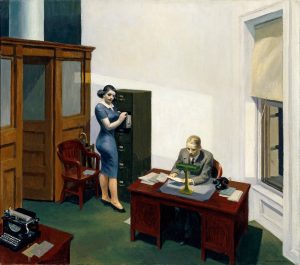Color and linework pop in Edward Hopper’s Office at Night (1940). Though the hues in the painting are bold, they are not bright. The furniture is burgundy and army green, and the floor is a murky aqua. While the lamp on the desk casts light onto the male figure and the paper he is holding, the lighting is still soft. Similarly, the light cast across the white wall is just bright enough to make the human figures stand out against the background. The colors across the canvas are mostly balanced in a subtle manner. Noticeably, the chair and desks match in color, as well as the typewriter and telephone. Less obviously, the papers around the room share similar hues from ash blue to off-white. The red lipstick the woman is wearing appears to match the man’s tie. The woman’s lipstick also forms a rectangle of the painting’s most vibrant colors, with the green and yellow of the lamp and the blue of the woman’s dress.
Speaking of rectangles, the shape is repeated throughout the image. The army green file cabinet, the desks, the sheets of paper, and the windows are all rectangular. The vertical lines that form most of these objects communicate a sense of order. The composition of the painting is indeed highly organized. In an interesting contrast, however, Hopper also uses many diagonal lines. As a result, the floor appears to be slightly tilted, as if everyone and everything in the room could slide to the right end. In fact, if the viewer visually traces the top right end of the brown door down to the woman’s head and further down toward the man, the viewer will notice a blatant diagonal composition forms. The diagonals also heighten the cramped sense of space, which in turn is emphasized by the strong offset of the colored environment against the white wall. The blankness of the off-white surface makes a small setting feel tinier, by intensifying the viewer’s attention on the colored area of the painting.
Hopper’s Office at Night also displays a strong sense of naturalism, despite the clear brushstrokes.

